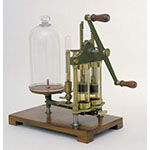Typical nineteenth-century French air pump, fairly common in physics laboratories until the early twentieth century. Mounted on a wooden base, it is fitted with two glass barrels whose pistons carry racks and are operated by a pinion with two handles. The mechanism is housed in a frame supported by a pair of small brass pillars. A stop-cock at the base of the barrels regulates the flow of air from the bell-jar, which rests on a metal plate covered by a ground-glass disk. In 1827, the Italian physicist Giuseppe Belli invented a special faucet for adjusting the connections between the pistons and the plate so as to obtain a better vacuum. This device was reinvented independently a few years later by Jacques Babinet, whose name is engraved on the faucet. A mercury pressure-gauge or manometer fitted with a second faucet is screwed onto the connection between the plate and the barrels. English-made pumps of this type always had brass barrels, while those made in France generally had glass barrels. Provenance: Lorraine collections.









